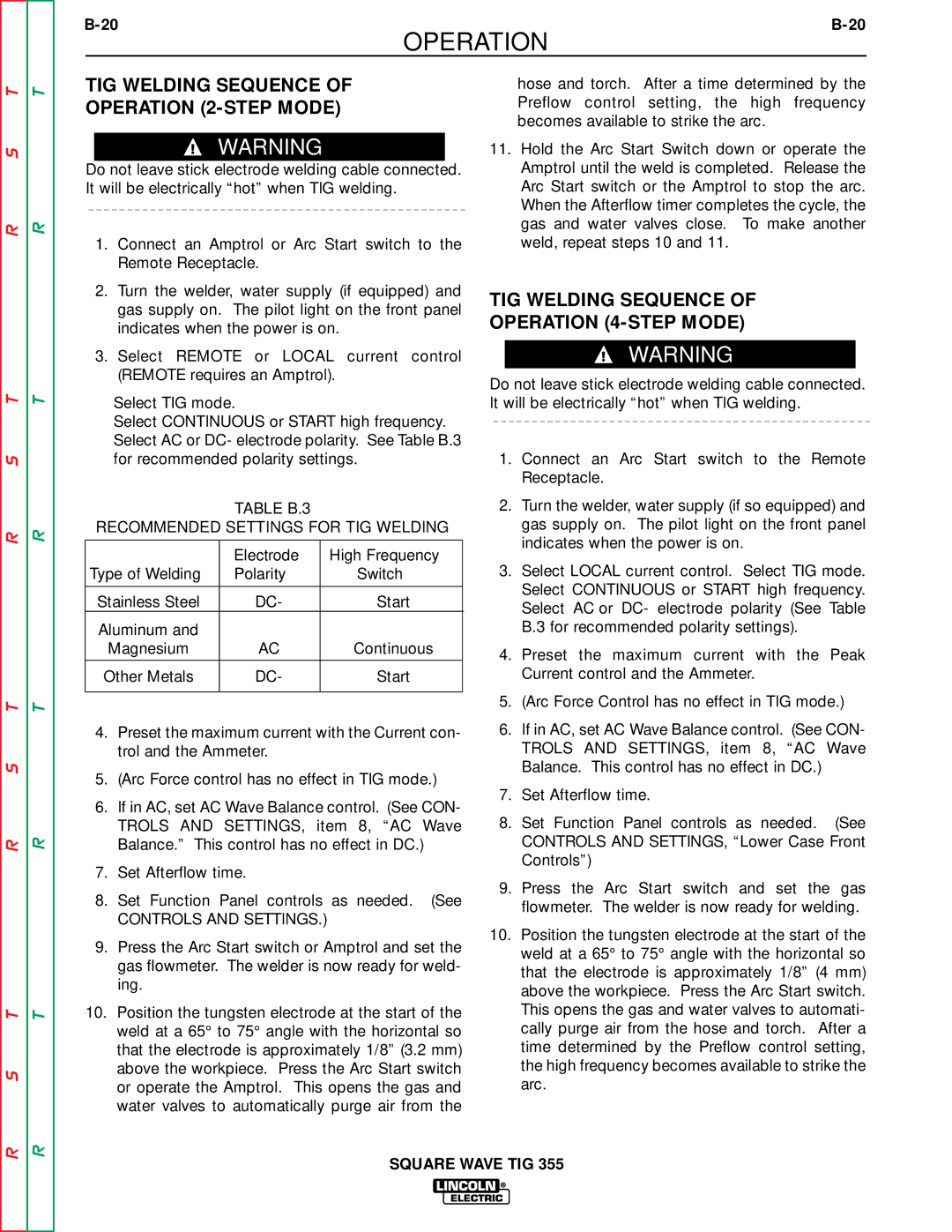
OPERATION
Return to Section TOC
TIG WELDING SEQUENCE OF
OPERATION (2-STEP MODE)
WARNING
Do not leave stick electrode welding cable connected. It will be electrically “hot” when TIG welding.
1.Connect an Amptrol or Arc Start switch to the Remote Receptacle.
hose and torch. After a time determined by the Preflow control setting, the high frequency becomes available to strike the arc.
11.Hold the Arc Start Switch down or operate the Amptrol until the weld is completed. Release the Arc Start switch or the Amptrol to stop the arc. When the Afterflow timer completes the cycle, the gas and water valves close. To make another weld, repeat steps 10 and 11.
to Section TOC
2.Turn the welder, water supply (if equipped) and gas supply on. The pilot light on the front panel indicates when the power is on.
3.Select REMOTE or LOCAL current control (REMOTE requires an Amptrol).
Select TIG mode.
Select CONTINUOUS or START high frequency. Select AC or DC- electrode polarity. See Table B.3 for recommended polarity settings.
TIG WELDING SEQUENCE OF
OPERATION (4-STEP MODE)
WARNING
Do not leave stick electrode welding cable connected. It will be electrically “hot” when TIG welding.
1.Connect an Arc Start switch to the Remote Receptacle.
Return
Return to Section TOC
Return to Section TOC
Return to Master TOC
Return to Master TOC
Return to Master TOC
Return to Master TOC
TABLE B.3
RECOMMENDED SETTINGS FOR TIG WELDING
| Electrode | High Frequency |
Type of Welding | Polarity | Switch |
|
|
|
Stainless Steel | DC- | Start |
Aluminum and |
|
|
Magnesium | AC | Continuous |
|
|
|
Other Metals | DC- | Start |
|
|
|
4.Preset the maximum current with the Current con- trol and the Ammeter.
5.(Arc Force control has no effect in TIG mode.)
6.If in AC, set AC Wave Balance control. (See CON- TROLS AND SETTINGS, item 8, “AC Wave Balance.” This control has no effect in DC.)
7.Set Afterflow time.
8.Set Function Panel controls as needed. (See
CONTROLS AND SETTINGS.)
9.Press the Arc Start switch or Amptrol and set the gas flowmeter. The welder is now ready for weld- ing.
10.Position the tungsten electrode at the start of the weld at a 65° to 75° angle with the horizontal so that the electrode is approximately 1/8” (3.2 mm) above the workpiece. Press the Arc Start switch or operate the Amptrol. This opens the gas and water valves to automatically purge air from the
2.Turn the welder, water supply (if so equipped) and gas supply on. The pilot light on the front panel indicates when the power is on.
3.Select LOCAL current control. Select TIG mode. Select CONTINUOUS or START high frequency. Select AC or DC- electrode polarity (See Table B.3 for recommended polarity settings).
4.Preset the maximum current with the Peak Current control and the Ammeter.
5.(Arc Force Control has no effect in TIG mode.)
6.If in AC, set AC Wave Balance control. (See CON- TROLS AND SETTINGS, item 8, “AC Wave Balance. This control has no effect in DC.)
7.Set Afterflow time.
8.Set Function Panel controls as needed. (See CONTROLS AND SETTINGS, “Lower Case Front Controls”)
9.Press the Arc Start switch and set the gas flowmeter. The welder is now ready for welding.
10.Position the tungsten electrode at the start of the weld at a 65° to 75° angle with the horizontal so that the electrode is approximately 1/8” (4 mm) above the workpiece. Press the Arc Start switch. This opens the gas and water valves to automati- cally purge air from the hose and torch. After a time determined by the Preflow control setting, the high frequency becomes available to strike the arc.
SQUARE WAVE TIG 355
